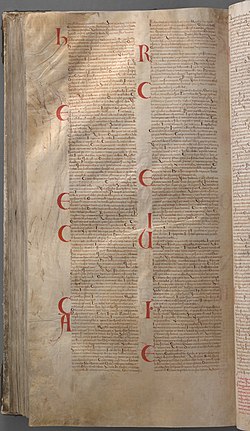Luke 21
| Luke 21 | |
|---|---|
 The Latin text of Luke 19:7–22:38 in Codex Gigas (13th century). | |
| Book | Gospel of Luke |
| Category | Gospel |
| Christian Bible part | New Testament |
| Order in the Christian part | 3 |
Luke 21 is the twenty-first chapter of the Gospel of Luke in the New Testament of the Christian Bible. It records the observations and predictions of Jesus Christ delivered in the temple in Jerusalem.[1] The book containing this chapter is anonymous, but early Christian tradition uniformly affirmed that Luke the Evangelist composed this Gospel as well as the Acts of the Apostles.[2]
Text
The original text was written in Koine Greek. This chapter is divided into 38 verses.
Textual witnesses
Some early manuscripts containing the text of this chapter are:
- Papyrus 75 (AD 175-225)
- Codex Vaticanus (325-350)
- Codex Sinaiticus (330-360)
- Codex Bezae (~400)
- Codex Washingtonianus (~400)
- Codex Alexandrinus (400-440)
- Codex Ephraemi Rescriptus (~450; extant verses 21-38)
Lesson of the widow's two mites (21:1-4)
Verses 1-4 record Jesus's observation that a poor widow, offering two mites, had genuinely contributed more to the temple than the gifts offered by rich people. Mark 12:41–44 records the same event.
The beauty of the Temple (21:5-6)
- Some spoke of the temple ... (verse 5: Greek: τινων λεγοντων περι του ιερου, tinōn legontōn peri tou hierou).
The New International Version translates these words as "Some of his disciples ...",[3] but some other versions suggest "some people" i.e. not specifically disciples of Jesus.[4] Protestant theologian Heinrich Meyer argues that "it is plain from the discourse itself" that Jesus was speaking to his disciples.[5]
The "beautiful stones" and the "gifts dedicated to God" both contribute to the splendor of the temple. Luke sets this dialogue inside the temple itself, whereas in Matthew and Mark it is set outside the temple.[5][6][7]
The destruction of the Temple (21:20-24)
Matthew and Mark state that Jesus spoke privately to his disciples on Mount Olivet about the end times and the destruction of Jerusalem: see Olivet Discourse. Luke does not present this teaching as delivered privately:
- In the daytime, He was teaching in the temple, but at night He went out and stayed on the mountain called Olivet. Then early in the morning all the people came to Him in the temple to hear Him.[8]
He tells them, These things which you see: the days will come in which not one stone shall be left upon another that shall not be thrown down.[9] They (whether it be his disciples or his audience more generally) ask when this will be. In Mark's account, the question is asked by Peter, James, John and Andrew.[10]
Parable of the Budding Fig Tree (21:29-33)

This parable was told by Jesus Christ and in the New Testament is found in Matthew Matthew 24:32–35, Mark Mark 13:28–31, and Luke Luke 21:29–33. This parable, about the Kingdom of God, involves a fig tree, as does the equally brief parable of the barren fig tree, with which it should not be confused. Luke presents this parable as eschatological in nature:[11] like the leaves of the fig tree, the signs spoken of in the Olivet discourse of Luke 21:5-28 [12] indicate the coming of the Kingdom of God.
See also
- Jerusalem
- Ministry of Jesus
- Olivet Discourse
- Parables of Jesus
- Other related Bible parts: Matthew 24, Mark 12, Mark 13
References
- ^ Halley, Henry H. Halley's Bible Handbook: an Abbreviated Bible Commentary. 23rd edition. Zondervan Publishing House. 1962.
- ^ Holman Illustrated Bible Handbook. Holman Bible Publishers, Nashville, Tennessee. 2012.
- ^ Luke 21:5
- ^ E.g. International Standard Version and New Century Version
- ^ a b Meyer, H. A. W. (1880), Meyer's NT Commentary on Luke 21, translated from the German sixth edition, accessed 4 February 2022
- ^ Matthew 24:1
- ^ Mark 13:1
- ^ Luke 21:37–38 NKJV
- ^ Luke 21:6
- ^ Mark 13:3–4
- ^ Bernard Brandon Scott, Hear Then the Parable: A commentary on the parables of Jesus, Fortress Press, 1989, ISBN 0-8006-2481-5, pp. 338-340.
- ^ Luke 21:5–28
External links
- Luke 21 King James Bible - Wikisource
- English Translation with Parallel Latin Vulgate
- Online Bible at GospelHall.org (ESV, KJV, Darby, American Standard Version, Bible in Basic English)
- Multiple bible versions at Bible Gateway (NKJV, NIV, NRSV etc.)
| Preceded by Luke 20 |
Chapters of the Bible Gospel of Luke |
Succeeded by Luke 22 |
